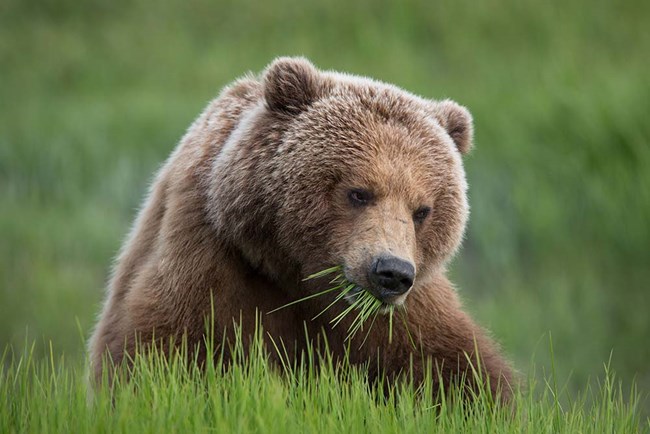Last updated: September 27, 2022
Article
What we can learn from a bear's stomach

NPS/Jim Pfeiffenberger
Sometimes, studies span the entire world; in this case, we studied the world within a brown bear’s stomach. Known as the gut microbiome (GMB), there is an entire ecosystem of organisms living in the stomach of animals. The GMB helps individuals get energy from their food, modulate immune responses, and stay healthy. As part of a large collaboration, we studied the GMB of bears from Katmai, Lake Clark, and Gates of the Arctic national parks and preserves using DNA. Katmai brown bears hosted the greatest diversity of organisms in their stomach, whereas Gates brown bears hosted the least diversity. We believe this GMB diversity is related to variety of foods that each bear’s population can access: Katmai bears live near the coast and have access to both terrestrial and marine foods, whereas a bear in the Brooks Range has fewer options. While very large bears had somewhat different gut microbiomes, there was no significant difference in them among healthy bears. This supports previous work that individual bears can reach the same body conditions (percent fat in their body) using very different diets in very different ecosystems. Monitoring GMBs could allow wildlife managers to quickly detect and assess the impact of disturbances on brown bear health.
Intrinsic and extrinsic factors influence on an omnivore’s gut microbiome
Abstract
Gut microbiomes (GMBs), complex communities of microorganisms inhabiting the gastrointestinal tracts of their hosts, perform countless micro-ecosystem services such as facilitating energy uptake and modulating immune responses. While scientists increasingly recognize the role GMBs play in host health, the role of GMBs in wildlife ecology and conservation has yet to be realized fully. Here, we use brown bears (Ursus arctos) as an ecological model to (1) characterize GMB community composition associated with location, season, and reproductive condition of a large omnivore; (2) investigate how both extrinsic and intrinsic factors influence GMB community membership and structure; and (3) quantify differences in GMB communities among different locations, seasons, sex, and reproductive conditions. To achieve these aims, we subsampled brown bear fecal samples collected during United States National Park Service research activities at three National Parks and Preserves (Katmai, Lake Clark, and Gates of the Arctic) and extracted microbial DNA for 16S rRNA amplicon sequencing and microbial taxonomic classification. We analyzed GMB communities using alpha and beta diversity indices, subsequently using linear mixed models to examine relationships between alpha diversity and extrinsic and intrinsic factors. Katmai brown bears hosted the greatest alpha diversity, whereas Gates brown bears hosted the least alpha diversity. Our results indicate that location and diet drive GMB variation, with bears hosting less phylogenetic diversity as park distance inland increases. Monitoring brown bear GMBs could enable managers to quickly detect and assess the impact of environmental perturbations on brown bear health. By integrating macro and micro-ecological perspectives we aim to inform local and landscape-level management decisions to promote long-term brown bear conservation and management.
Trujillo, S. M., E. A. McKenney, G. V. Hilderbrand, L. S. Mangipane, M. C. Rogers, K. Joly, D. D. Gustine, J. A. Erlenbach, B. A. Mangipane, and D. J. R. Lafferty. 2022. Intrinsic and extrinsic factors influence on an omnivore's gut microbiome. PLOS ONE 17(4): e0266698.
Correlating gut microbial membership to brown bear health metrics
Abstract
The internal mechanisms responsible for modulating physiological condition, particularly those performed by the gut microbiome (GMB), remain under-explored in wildlife. However, as latitudinal and seasonal shifts in resource availability occur, the myriad micro-ecosystem services facilitated by the GMB may be especially important to wildlife health and resilience. Here, we use brown bears (Ursus arctos) as an ecological model to quantify the relationship between wildlife body condition metrics that are commonly used to assess individual and population-level health and GMB community composition and structure. To achieve these aims, we subsampled brown bear fecal samples collected during United States National Park Service research activities at three National Parks and Preserves (Katmai, Lake Clark, and Gates of the Arctic) and extracted microbial DNA for 16S rRNA amplicon sequencing and microbial taxonomic classification. We analyzed GMB communities using alpha diversity indices, subsequently using Spearman’s correlation analysis to examine relationships between alpha diversity and brown bear health metrics. We found no differences in GMB composition among bears with differing body conditions, nor any correlations between alpha diversity and body condition. Our results indicate that GMB composition reflects diverse foraging strategies while allowing brown bears to achieve similar body condition outcomes.
Trujillo, S. M., E. A. McKenney, G. V. Hilderbrand, L. S. Mangipane, M. C. Rogers, K. Joly, D. D. Gustine, J. A. Erlenbach, B. A. Mangipane, and D. J. R. Lafferty. 2022. Correlating gut microbial membership to brown bear health metrics. Scientific Reports 12: 15415.
